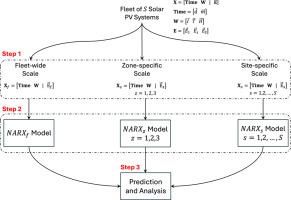A tiered NARX model for forecasting day-ahead energy production in distributed solar PV systems
IF 5.3
Q2 ENGINEERING, ENVIRONMENTAL
引用次数: 0
Abstract
This study presents a hierarchical forecasting approach for day-ahead energy production in distributed solar Photovoltaic (PV) systems using a tiered Nonlinear Autoregressive Exogenous (NARX) model. The methodology was applied to 52 PV systems installed at The University of Jordan, covering three prediction scales: fleet-wide, zone-specific, and site-specific. The model incorporated weather data, including solar irradiation, temperature, and humidity, to forecast the next day's energy production. Based on a new metric called the , fleet-wide predictions outperform the zone-specific and site-specific averages by 3.21% and 5.35%, respectively. Normalized Root Mean Square Errors () for fleet-wide, zone-specific, and site-specific predictions are 0.148, 0.141, and 0.137, respectively. The Correlation Coefficient () is above 80% for all prediction scales, with the accuracy constrained by the model's difficulty in adapting to abrupt weather changes, leading to overestimation. The model performs best when weather patterns and PV generation are consistent with previous days. This demonstrates that adapting models to the characteristics of each scale significantly improves forecast accuracy, enabling more effective macro-level planning and micro-level operational decisions.

用于预测分布式太阳能光伏系统日前发电量的分层 NARX 模型
本研究采用分层非线性自回归外生(NARX)模型,对分布式太阳能光伏(PV)系统的日前发电量进行分层预测。该方法适用于约旦大学安装的 52 个光伏系统,涵盖三个预测尺度:整个机组、特定区域和特定地点。该模型纳入了天气数据,包括太阳辐照度、温度和湿度,以预测第二天的发电量。根据名为 "OverallMetric "的新指标,整个车队的预测结果比特定区域和特定地点的平均值分别高出 3.21% 和 5.35%。整个机群、特定区域和特定地点预测的归一化均方根误差(nRMSE)分别为 0.148、0.141 和 0.137。所有预测尺度的相关系数(R)均在 80% 以上,但由于模型难以适应天气的突然变化,导致高估,因此精度受到限制。当天气模式和光伏发电量与前几天一致时,模型的表现最佳。这表明,根据各尺度的特点调整模型可显著提高预测精度,从而实现更有效的宏观规划和微观运营决策。
本文章由计算机程序翻译,如有差异,请以英文原文为准。
求助全文
约1分钟内获得全文
求助全文
来源期刊

Cleaner Engineering and Technology
Engineering-Engineering (miscellaneous)
CiteScore
9.80
自引率
0.00%
发文量
218
审稿时长
21 weeks
 求助内容:
求助内容: 应助结果提醒方式:
应助结果提醒方式:


